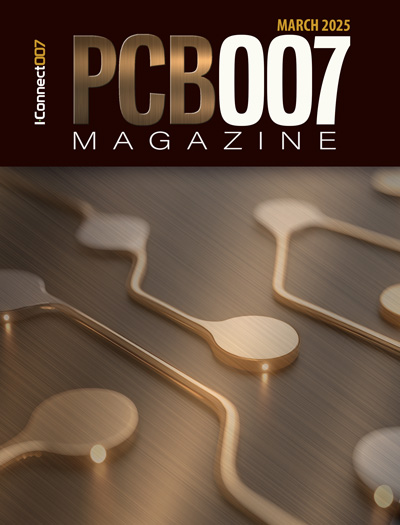-

- News
- Books
Featured Books
- pcb007 Magazine
Latest Issues
Current Issue
The Essential Guide to Surface Finishes
We go back to basics this month with a recount of a little history, and look forward to addressing the many challenges that high density, high frequency, adhesion, SI, and corrosion concerns for harsh environments bring to the fore. We compare and contrast surface finishes by type and application, take a hard look at the many iterations of gold plating, and address palladium as a surface finish.

It's Show Time!
In this month’s issue of PCB007 Magazine we reimagine the possibilities featuring stories all about IPC APEX EXPO 2025—covering what to look forward to, and what you don’t want to miss.

Fueling the Workforce Pipeline
We take a hard look at fueling the workforce pipeline, specifically at the early introduction of manufacturing concepts and business to young people in this issue of PCB007 Magazine.
- Articles
- Columns
Search Console
- Links
- Media kit
||| MENU - pcb007 Magazine
IDTechEx Report Unveils 3D Electronics Status and Opportunities
April 22, 2024 | PRNewswireEstimated reading time: 4 minutes
3D electronics is an emerging manufacturing approach that enables electronics to be integrated within or onto the surface of objects. 3D electronic manufacturing techniques empower new features, including mass customizability, greater integration, and improved sustainability in the electronics industry. There are three main approaches to 3D electronics: applying electronics to a 3D surface, in-mold electronics, and fully printed 3D electronics. Each approach is discussed in detail in the newly launched IDTechEx report "3D Electronics/Additive Electronics 2024-2034: Technologies, Players, and Markets".
Applying electronics to 3D surfaces
The most established approach to adding electrical functionality onto the surface of 3D objects is laser direct structuring (LDS). LDS saw tremendous growth around a decade ago and is used to manufacture hundreds of millions of devices each year, including antennas and simple conductive interconnects to the surface of 3D injection-molded plastic objects. However, despite its high patterning speed and widespread adoption, LDS has some weaknesses that leave space for alternative approaches to surface metallization. For example, valve jet printing, also known as dispensing, is already being used for a small proportion of antennas. This technique enables the rapid deposition of a wide range of materials.
Aerosol jetting and laser-induced forward transfer (LIFT) are other digital deposition technologies covered in the report. These technologies offer higher resolutions and rapid deposition of a wide range of materials, respectively. The IDTechEx report also benchmarks other emerging techniques, such as ultra-precision dispensing, electrohydrodynamic printing, impulse printing, pad printing, and spray metallization. IDTechEx forecasts a gradual growth in the market for partially additive electronics, particularly in the telecommunications and microelectronics sectors.
In-mold electronics
In-mold electronics (IME), in which electronics are printed/mounted prior to thermoforming into a 3D component, facilitate the transition towards greater integration of electronics, especially where capacitive touch sensing and lighting are required. IME offers multiple advantages relative to conventional mechanical switches, including a reduction in weight and material consumption of up to 70% and much simpler assembly.
The IME manufacturing process can be regarded as an extension of the well-established in-mold decorating (IMD) process. Thus, much of the existing process knowledge and capital equipment can be reused. IME differs from IMD through the initial screen printing of conductive thermoformable inks, followed by the deposition of electrically conductive adhesives and the mounting of SMDs (surface mount devices, primarily LEDs at present). More complex multilayer circuits can also be produced by printing dielectric inks to enable crossovers.
Despite the advantageous features, commercial deployment of IME-integrated SMD components has thus far been fairly limited. This relatively slow adoption, especially within the primary target market of automotive interiors, is attributed to both the challenges of meeting automotive qualification requirements and the range of less sophisticated alternatives, such as applying functional films to thermoformed parts. Along with greater acceptance of the technology, the adoption of IME will require clear design rules, materials that conform to established standards, and, crucially, the development of electronic design tools. IDTechEx predicts that the most significant growth in 3D electronics will occur in in-mold electronics (IME) once it passes its validation stage.
Fully printed 3D electronics
Arguably, the most innovative approach to additive electronics is fully printed 3D electronics, in which dielectric and conductive materials are sequentially deposited. Combined with placed SMD components, this results in a circuit, potentially with a complex multilayer structure embedded in a 3D plastic object. The core value proposition is that each object and embedded circuit can be manufactured using a different design without the expense of manufacturing masks and molds each time.
Fully 3D printed electronics are thus well suited to applications where a wide range of components need to be manufactured at short notice. The technology is also promising for applications where a customized shape and even functionality are important. The ability of 3D printed electronics to manufacture different components using the same equipment and the associated decoupling of unit cost and volume could also enable a transition to on-demand manufacturing.
The challenge for fully 3D printed electronics is that manufacturing is fundamentally a much slower process than making parts via injection molding since each layer needs to be deposited sequentially. While the printing process can be accelerated using multiple nozzles, it is best targeted at applications where customizability offers a tangible advantage. Ensuring reliability is also a challenge, considering different material properties; additionally, with embedded electronics, post hoc repairs are impossible - one strategy is using image analysis to check each layer and perform any repairs before the next layer is deposited.
Comprehensive analysis and market forecasts
The new IDTechEx report, "3D Electronics/Additive Electronics 2024-2034: Technologies, Players, and Markets", analyzes the technologies and market trends that promise to bring electronics manufacturing into the 3D realm. Drawing from over 30 company profiles, the report assesses three distinct segments of the 3D electronics landscape. The IDTechEx report evaluates each segment's different technologies, potential adoption barriers, and application opportunities.
IDTechEx's new report also includes detailed 10-year market forecasts for each 3D electronics manufacturing technology, segmented by application sector and delineated by both revenue and area/volume.
Suggested Items
I-Connect007 Editor’s Choice: Five Must-Reads for the Week
04/04/2025 | Nolan Johnson, I-Connect007There was big news throughout the week on a global economic scale. Everything is moving so fast it’s hard to follow. I sat in on a webinar about the U.S. tariff changes announced on April 2, and even the policy wonks, whose life’s purpose is to be expert in these things, couldn’t keep up. One speaker was checking government information websites, and listening to the news on the television even as she gave her update.
'Let’s Talk Production Test' with Bert Horner of The Test Connection, Inc. at SMTA Long Island Chapter Technical Meeting
04/04/2025 | The Test Connection Inc.The Test Connection Inc. (TTCI), a leading provider of electronic test and manufacturing solutions, is pleased to announce that its President, Bert Horner, will present at the SMTA Long Island Chapter Technical Meeting & Dinner on Wednesday, April 16, 2025.
TT Electronics Celebrates 35 Years of Dedication with Rhys Moseley
04/04/2025 | TT ElectronicsAt TT Electronics, the commitment to people as the cornerstone of success is showcased through the remarkable achievements of its employees.
Kasuo Electronics Expands Global Reach with Launch of Online Store for Seamless Component Sourcing
04/04/2025 | PRNewswireKasuo Electronics Co., Ltd. is a professional distributor of electronic components, specializing in integrated circuits (ICs), capacitors, resistors, ferrite beads, inductors, and a wide range of electronic parts.
Acquisition of MADES Strengthens Cicor's Pan-European Leadership in the Aerospace & Defence Sector
04/03/2025 | CicorCicor Group announces that it has signed an agreement to acquire 100% of the shares of Spanish electronics company Malaga Aerospace, Defense & Electronics Systems S.A.U. (MADES).


